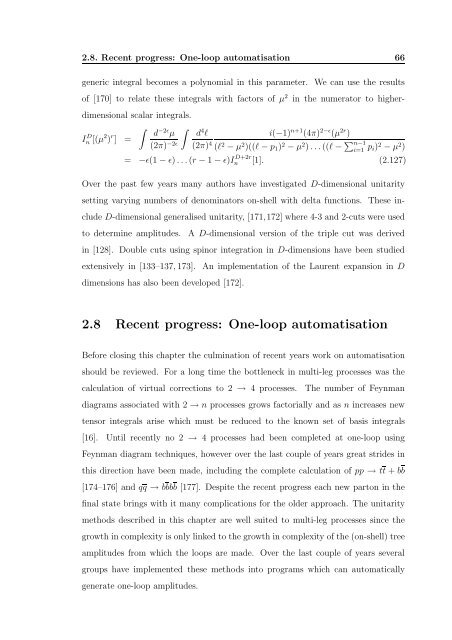Hadronic production of a Higgs boson in association with two jets at ...
Hadronic production of a Higgs boson in association with two jets at ...
Hadronic production of a Higgs boson in association with two jets at ...
You also want an ePaper? Increase the reach of your titles
YUMPU automatically turns print PDFs into web optimized ePapers that Google loves.
2.8. Recent progress: One-loop autom<strong>at</strong>is<strong>at</strong>ion 66generic <strong>in</strong>tegral becomes a polynomial <strong>in</strong> this parameter. We can use the results<strong>of</strong> [170] to rel<strong>at</strong>e these <strong>in</strong>tegrals <strong>with</strong> factors <strong>of</strong> µ 2 <strong>in</strong> the numer<strong>at</strong>or to higherdimensionalscalar <strong>in</strong>tegrals.∫ dIn D [(µ2 ) r −2ǫ ∫µ d 4 li(−1) n+1 (4π) 2−ǫ (µ 2r )] =(2π) −2ǫ (2π) 4 (l 2 − µ 2 )((l − p 1 ) 2 − µ 2 ) . . .((l − ∑ n−1i=1 p i) 2 − µ 2 )= −ǫ(1 − ǫ) . . .(r − 1 − ǫ)In D+2r [1]. (2.127)Over the past few years many authors have <strong>in</strong>vestig<strong>at</strong>ed D-dimensional unitaritysett<strong>in</strong>g vary<strong>in</strong>g numbers <strong>of</strong> denom<strong>in</strong><strong>at</strong>ors on-shell <strong>with</strong> delta functions. These <strong>in</strong>cludeD-dimensional generalised unitarity, [171,172] where 4-3 and 2-cuts were usedto determ<strong>in</strong>e amplitudes. A D-dimensional version <strong>of</strong> the triple cut was derived<strong>in</strong> [128]. Double cuts us<strong>in</strong>g sp<strong>in</strong>or <strong>in</strong>tegr<strong>at</strong>ion <strong>in</strong> D-dimensions have been studiedextensively <strong>in</strong> [133–137, 173]. An implement<strong>at</strong>ion <strong>of</strong> the Laurent expansion <strong>in</strong> Ddimensions has also been developed [172].2.8 Recent progress: One-loop autom<strong>at</strong>is<strong>at</strong>ionBefore clos<strong>in</strong>g this chapter the culm<strong>in</strong><strong>at</strong>ion <strong>of</strong> recent years work on autom<strong>at</strong>is<strong>at</strong>ionshould be reviewed. For a long time the bottleneck <strong>in</strong> multi-leg processes was thecalcul<strong>at</strong>ion <strong>of</strong> virtual corrections to 2 → 4 processes. The number <strong>of</strong> Feynmandiagrams associ<strong>at</strong>ed <strong>with</strong> 2 → n processes grows factorially and as n <strong>in</strong>creases newtensor <strong>in</strong>tegrals arise which must be reduced to the known set <strong>of</strong> basis <strong>in</strong>tegrals[16]. Until recently no 2 → 4 processes had been completed <strong>at</strong> one-loop us<strong>in</strong>gFeynman diagram techniques, however over the last couple <strong>of</strong> years gre<strong>at</strong> strides <strong>in</strong>this direction have been made, <strong>in</strong>clud<strong>in</strong>g the complete calcul<strong>at</strong>ion <strong>of</strong> pp → tt + bb[174–176] and qq → bbbb [177]. Despite the recent progress each new parton <strong>in</strong> thef<strong>in</strong>al st<strong>at</strong>e br<strong>in</strong>gs <strong>with</strong> it many complic<strong>at</strong>ions for the older approach. The unitaritymethods described <strong>in</strong> this chapter are well suited to multi-leg processes s<strong>in</strong>ce thegrowth <strong>in</strong> complexity is only l<strong>in</strong>ked to the growth <strong>in</strong> complexity <strong>of</strong> the (on-shell) treeamplitudes from which the loops are made. Over the last couple <strong>of</strong> years severalgroups have implemented these methods <strong>in</strong>to programs which can autom<strong>at</strong>icallygener<strong>at</strong>e one-loop amplitudes.
















